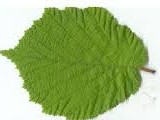 The giant filbert is a deciduous shrub or small tree native to southeastern Europe and southwestern Asia but it widely cultivated for its edible nuts which have a sweet, rich flavor. It is a member of the birch family (Betulacea) that also includes alders, hornbeams, and hazels. The simple, alternate leaves are slightly lobed, doubled-toothed, lightly hairy, and 3 to 5 inches long by 2 to 3.5 inches wide. They are dark green most of the growing season but may turn an uninteresting shade of yellow in fall. Male and female flowers are produced in pale yellow or red catkins respectively on the same tree before the leaves appear in late winter to early spring. Female flowers produce clusters of one to five nuts, each of which is enclosed in long, tubular involucre that extends beyond the nut. Since cross-pollination is necessary for fruit set, two or more varieties should be planted. Giant filbert only does well in places such as the Pacific Northwest where cool temperatures and moisture prevail. The generic name, Corylus, comes from the Greek word, korylos, meaning helmet, and refers to the involucre on the nut. Specific epithet, maxima, is the Latin word meaning largest.
The giant filbert is a deciduous shrub or small tree native to southeastern Europe and southwestern Asia but it widely cultivated for its edible nuts which have a sweet, rich flavor. It is a member of the birch family (Betulacea) that also includes alders, hornbeams, and hazels. The simple, alternate leaves are slightly lobed, doubled-toothed, lightly hairy, and 3 to 5 inches long by 2 to 3.5 inches wide. They are dark green most of the growing season but may turn an uninteresting shade of yellow in fall. Male and female flowers are produced in pale yellow or red catkins respectively on the same tree before the leaves appear in late winter to early spring. Female flowers produce clusters of one to five nuts, each of which is enclosed in long, tubular involucre that extends beyond the nut. Since cross-pollination is necessary for fruit set, two or more varieties should be planted. Giant filbert only does well in places such as the Pacific Northwest where cool temperatures and moisture prevail. The generic name, Corylus, comes from the Greek word, korylos, meaning helmet, and refers to the involucre on the nut. Specific epithet, maxima, is the Latin word meaning largest.

Type: Deciduous shrub or small tree
Outstanding Feature: Nuts
Form: Vase-shape
Growth Rate: Moderate

Bloom: Male and female flowers produced in pale yellow or red catkins, respectively, appear before leaves in late winter to early spring.
Size: 12-30’ H x 10-25’ W
Light: Full sun to part shade
Soil: Fertile, moist, well-drained
Hardiness: Zones 4-8
Care: Prune whips to 2’, leaving six branches to produce vase form. Cut back strong branches to encourage spurs that will bear nuts. Remove suckers.
Pests and Diseases: Susceptible to aphids, mites, scale, leafhoppers, caterpillars, leaf spots, blight, crown gall
Propagation: Layering, grafting, softwood cuttings
Selections: Barcelona, DuChilly, White Aveline; a purple-leaved selection, C. maxima ‘Purpurea’ is available.